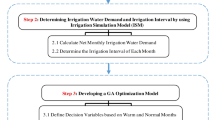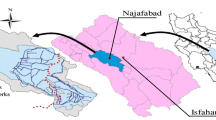Abstract
For ensuring both optimal sustainable water resources management and long-term planning in a changing arid environment, we propose an integrated Assessment-, Prognoses-, Planning- and Management tool (APPM). The new APPM integrates the complex interactions of the strongly nonlinear meteorological, hydrological and agricultural phenomena, considering the socio-economic aspects. It aims at achieving best possible solutions for water allocation, groundwater storage and withdrawals including saline water management together with a substantial increase of the water use efficiency employing novel optimisation strategies for irrigation control and scheduling. To obtain a robust and fast operation of the water management system, it unites process modeling with artificial intelligence tools and evolutionary optimisation techniques for managing both water quality and quantity. We demonstrate some key components of our methodology by an exemplary application to the south Al-Batinah region in the Sultanate of Oman which is affected by saltwater intrusion into a coastal aquifer due to excessive groundwater withdrawal for irrigated agriculture. We show the effectiveness and functionality of a new simulation-based water management system for the optimisation and evaluation of different irrigation practices, crop pattern and resulting abstraction scenarios. The results of several optimisation runs indicate that due to contradicting objectives, such as profit-oriented agriculture versus aquifer sustainability only a multi-objective optimisation can provide sustainable solutions for the management of the water resources in respect of the environment as well as the socio-economic development.










Similar content being viewed by others
References
Abdelrahman HA, Lepiece A, Macalinga V (1993) Some physical and chemical characteristics of the Batinah Soils. Commun Soil Sci Plant Anal 24(17–18):2293–2305
Agricultural Census (2005) Sultanate of Oman, Ministry of Agriculture and Fisheries, Director General of Planning and Investment Promotion. Department of Statistics and Information
Al-Hattaly S, Al-Kindy M (2008) Water resources assessment and the evaluation of expected impacts of climatic change in Oman. In: International conference water resources and climate change in the MENA region, Sultanate of Oman
Al-Shaqsi SRS (2004) The socio economic and cultural aspects in the implementation of water demand management, a case study in the Sultanate of Oman. Department of Geography, University of Nottingham
Bhattacharjya RK, Datta B (2009) ANN-GA-based model for multiple objective management of coastal aquifers. J Water Resour Plan Manag ASCE 135(5):314–322
Dhar A, Datta B (2009) Saltwater intrusion management of coastal aquifers. I: linked simulation-optimization. J Hydrol Eng 14(12):1263–1272
FAO (2008) Geography, climate, population. Technical report, FAO’s information system on water and agriculture AQUASTAT
Feyen L, Gorelick SM (2004) Reliable groundwater management in hydroecologically sensitive areas. Water Resour Res 40(7):W07408
Goldberg DE (1989) Genetic algorithms in search, optimization, and machine learning. Addison-Wesley Publishing Company, Reading
Gosavi A (2003) Simulation-based optimization: a parametric optimization techniques and reinforcement learning. Kluwer Academics Publishers, The Netherlands
Hansen N (2006) The CMA evolution strategy: a comparing review. In: Lozano JA, Larranaga P, Inza I, Bengoetxea E (eds) Towards a new evolutionary computation, advances on estimation of distribution algorithms. Springer, Berlin, pp 75–102
Harou JJ, Pulido-Velazquez M, Rosenberg DE, Medellin-Azuara J, Lund JR, Howitt RE (2009) Hydro-economic models: concepts, design, applications, and future prospects. J Hydrol 375(3–4):627–643
IPCC (2007) Climate change 2007: the physical science basis. Contribution of working group I to the fourth assessment report of the intergovernmental panel on climate change. Technical report, Cambridge, UK
Kacimov AR, Sherif MM, Perret A (2009) Control of sea-water intrusion by salt-water pumping: Coast of Oman. Hydrogeol J 17:541–558
Kalbacher T, Delfs JO, Shao H, Wang W, Walther M, Samaniego L, Schneider C, Musolff A, Centler F, Sun F, Hildebrandt A, Liedl R, Borchardt D, Krebs P, Kolditz O (2011) The IWAS-ToolBox: Software coupling for an integrated water resources management. Environ Earth Sci. doi:10.1007/s12665-011-1270-y (this issue)
Kalbus E, Kalbacher T, Kolditz O, Krüger E, Seegert J, Teutsch G, Borchardt D, Krebs P (2011) Foreword to the special issue on integrated water resources management under different hydrological, climatic and socio-economic conditions (IWAS project). Environ Earth Sci. doi:10.1007/s12665-011-1330-3 (this issue)
Keating BA, Carberry PS, Hammer GL, Probert ME, Robertson MJ, Holzworth D, Huth NI, Hargreaves JNG, Meinke H, Hochman Z, McLean G, Verburg K, Snow V, Dimes JP, Silburn M, Wang E, Brown S, Bristow KL, Asseng S, Chapman S, McCown RL, Freebairn DM, Smith CJ (2003) An overview of APSIM, a model designed for farming systems simulation. Eur J Agron 18:267–288
Kolditz O, Delfs JO, Bürger CM, Beinhorn M, Park C-H (2008) Numerical analysis of coupled hydrosystems based on an object-oriented compartment approach. J Hydroinf 10(3):227–244. doi:10.2166/hydro.2008.003
Labadie JW (2004) Optimal operation of multireservoir systems: state-of-the-art review. J Water Resour Plan Manag ASCE 130(2):93–111
Loucks DP, van Beek E (2005) Water resources systems planning and management: an introduction to methods, models and applications. UNESCO, Paris
Malik AS, Al-Zubeidi S (2006) Electricity tariffs based on long-run marginal costs for central grid system of Oman. Energy 31(12):1703–1714
Nabney IT (2002) Netlab algorithms for pattern recognition. Springer, London
Philipp A, Schmitz GH, Liedl R (2010) An analytical model of surge flow in non-prismatic permeable channels and its application in Arid regions. J Hydraul Eng 136(5):290–298
Rao S, Sreenivasulu V, Bhallamudi S, Thandaveswara B, Sudheer K (2004) Planning groundwater development in coastal aquifers. Hydrological Sciences Journal-Journal des Sciences Hydrologiques 49:155–170
Rejani R, Jha MK, Panda SN (2009) Simulation-optimization modelling for sustainable groundwater management in a coastal basin of Orissa, India. Water Resour Manag 23(2):235–263
Rossman LA (2000) EPANET users manual
Schmitz GH, Cullmann J (2008) PAI-OFF: a new proposal for online flood forecasting in flash flood prone catchments. J Hydrol 360:1–14
Schmitz GH, Woehling T, de Paly M, Schütze N (2007a) GAIN-P: a new strategy to increase furrow irrigation efficiency. Arab J Sci Eng 32(1C):103–114
Schmitz GH, Schütze N, Woehling T (2007b) Irrigation control: towards a new solution of an old problem. UNESCO’s intergovernmental scientific programme in water resources: international hydrological programme (IHP), Studies and Reports in Hydrology, p 222
Schütze N, Schmitz GH (2010) OCCASION: a new planning tool for optimal climate change adaption strategies in irrigation. J Irrigation Drainage Eng. http://dx.doi.org/10.1061/(ASCE)IR.1943-4774.0000266
Schütze N, Schmitz GH, Petersohn U (2005) Self-organizing maps with multiple input-output option for modeling the Richards equation and its inverse solution. Water Resour Res 41. doi:10.1029/2004WR003630
Schütze N, de Paly M, Shamir U (2011a) Novel simulation-based algorithms for optimal open-loop and closed-loop scheduling of deficit irrigation systems. J Hydroinf. doi:10.2166/hydro.2011.073
Schütze N, Kloss S, Lennartz F, Al Bakri A, Schmitz GH (2011b) Optimal planning and operation of irrigation systems under water resource constraints in Oman considering climatic uncertainty. Environ Earth Sci. doi:10.1007/s12665-011-1135-4 (this issue)
Semenov MA, Brooks RJ, Barrow EM, Richardson CW (1998) Comparison of the WGEN and LARS-WG stochastic weather generators for diverse climates. Clim Res 10(2):95–107
Statistical Year book (2008) Sultanate of Oman Ministry of National Economy
Steppuhn H, Genuchten MT, van Grieve CM (2005) Root-zone salinity: II. Indices for tolerance in agricultural crops. Crop Sci 45(1):221–232
The World Bank (ed) (2007) The International Bank for Reconstruction and Development: MENA development report. Making the most of scarcity. Accountability for better water management results in the Middle East and North Africa. Washington. http://siteresources.worldbank.org/INTMENA/Resources/00a-Front-Scarcity.pdf
Walther M, Kolditz O, Grundmann J, Liedl R (2010) Groundwater modeling in coastal Arid regions under the influence of marine saltwater intrusion. EGU General Assembly, Vienna
Yan S, Minsker B (2006) Optimal groundwater remediation design using an Adaptive Neural Network Genetic Algorithm. Water Resour Res 42
Acknowledgments
The manuscript was prepared within the research project IWAS funded by the German Federal Ministry of Education and Research (BMBF) under grant no. 02WM1028. Additionally, we wish to thank the Ministry of Regional Municipalities and Water Resources of the Sultanate of Oman for supporting the IWAS-IWRM project.
Author information
Authors and Affiliations
Corresponding author
Rights and permissions
About this article
Cite this article
Grundmann, J., Schütze, N., Schmitz, G.H. et al. Towards an integrated arid zone water management using simulation-based optimisation. Environ Earth Sci 65, 1381–1394 (2012). https://doi.org/10.1007/s12665-011-1253-z
Received:
Accepted:
Published:
Issue Date:
DOI: https://doi.org/10.1007/s12665-011-1253-z




